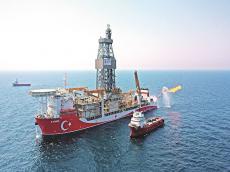|
|
TODAY.AZ / World news
The Black Sea gas extraction works are carried out at a depth of 2,200 meters
16 June 2022 [13:00] - TODAY.AZ

By Azernews
By Fazl? Sahan
Strenuous efforts are underway at Filyos Port, where the 540 billion cubic meters of gas from the Amasra-1 well in the Sakarya Gas Field will meet with the land, Yeni Shafak daily has reported.
At 2,200 meters below sea level, 12 kilometers of equipment are put between the wells, the report added.
The natural gas discovery, which was announced on August 21, 2020, as 320 billion cubic meters in the Tuna-1 well in the Sakarya Gas Field, increased to 405 billion cubic meters on October 17, 2020, with the discovery of 135 billion cubic meters in the Amasra-1 well, totaling 540 billion cubic meters.
Simultaneously with the discoveries, construction of the infrastructure that will transport the gas to the land and from there to the network began. In this backdrop, Turkey had another historic day in the Black Sea gas production at the start of the week. The nation witnessed the first pipe lowering and welding ceremony in the sea.
The Energy and Natural Resources Ministry is working nonstop to bring this wealth to the country. The ministry works both underwater and on land at the same time. The installation work at Filyos Port, where the gas will touch the earth, is reminiscent of a spider web. Authorities stressed the importance of concurrent task execution by saying, "If one starts after the other, this project will not be completed in 8-10 years".
According to the officials, the piping work is scheduled to be completed by the end of 2022. Pipes are laid under the sea in three lines, rather than one. There is a 16-inch pipeline to carry the gas and next to it, there is another line where various chemicals will be sent to the field to assist. From the third line, these works in the field will be inspected, and the control task will be carried out. On the other hand, BOTAS is working on another 35-36 kilometer line for connection to the main line in Zonguldak. The pipes have arrived, their routes have been determined, and the work continues rapidly.
The wellhead valves are first lowered into the wells to clean the wellhead. The robots then start cleaning the inside of the well. The 65-ton valve, which is lowered after the wellhead is opened, is placed here. This is a very delicate stage since the width, height, and direction of the valve must be correct from every angle. After all the tests are completed, the wellhead is ready for production. There is also a 230-250-ton manifold that is lowered into the sea together with 3-4 robots.
There is 5,200 personnel working on land and at sea, 1,800 of whom are involved offshore. The project has encompassed 25 ships as well as 12-13 helicopters. Personnel and materials are transported by air. As work nears completion, the number of personnel and equipment will grow even more. After one month, the number of ships is expected to rise to 45, with a 1,000-1,500 increase in manpower. The study includes both foreigners and Turks.16 people from European and Asian countries, who received Turkish citizenship, are on the field too.
As in the discovery, the main work is being carried out in the Black Sea region in delivering the gas to the houses. These inconspicuous studies are quite interesting. The equipment is placed at a depth of 2,200 meters. The distance from one end of the equipment to the other is 12 kilometers. The tasks are all performed by robots. The works are separated into blocks beneath the water, with Phase-1 of the first block having completed 66 percent of the work.
URL: http://www.today.az/news/regions/221712.html
 Print version
Print version
Connect with us. Get latest news and updates.
See Also
- 18 November 2024 [23:50]
North Korea launched garbage balloons into South Korea again - 18 November 2024 [22:27]
Milan topped list of most comfortable cities in Italy - 18 November 2024 [21:22]
US nuclear submarine entered the port of South Korea to replenish supplies - 18 November 2024 [20:18]
Finland raises defense spending to required NATO level - 18 November 2024 [13:23]
Pashinyan confirms high-profile resignations in Armenian government - 17 November 2024 [23:21]
Taiwan Foreign Minister leads drone tech delegation to Lithuania - 17 November 2024 [22:27]
Xi Jinping seeks stable US-China relations ahead of Trump’s return to office - 17 November 2024 [21:30]
Australia, Japan, and US strengthen military cooperation to counter China - 17 November 2024 [20:34]
Trump appoints fossil fuel Executive Chris Wright as Energy Secretary in second term - 17 November 2024 [19:20]
Voting begins in Senegal’s early Parliamentary Elections for New National Assembly
Most Popular
 Azerbaijan and COP29: a real approach and an example for everyone
Azerbaijan and COP29: a real approach and an example for everyone
 Macron received a slap in the face from the Vatican
Macron received a slap in the face from the Vatican
 Baku made Paris panic. What was Macron afraid of?
Baku made Paris panic. What was Macron afraid of?
 Azerbaijani activists protest U.S. Congressman Frank Pallone, demand apology and legal action
Azerbaijani activists protest U.S. Congressman Frank Pallone, demand apology and legal action
 COP29 panel explores role of SMEs in green economy transition
COP29 panel explores role of SMEs in green economy transition
 Azerbaijan, UN Office on Drug & Crime mull coop in combating transnational crime
Azerbaijan, UN Office on Drug & Crime mull coop in combating transnational crime
 USA, South Korea & Japan strengthen their missile defense capabilities
USA, South Korea & Japan strengthen their missile defense capabilities
